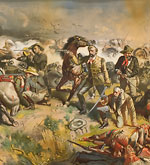Michigan’s Bibliomaniac
The last years of Clements’ life brought a mix of happiness and distress. His wife divorced him in 1930, but he remarried the following year. In the summer of 1931 his Bay City bank closed, and Clements poured a great deal of his own money into getting it reopened in 1932. A Democratic landslide in Michigan’s spring 1933 elections cost him his seat on the university board, ending his 24-year tenure as a regent. Keeping a close eye on the Clements Library provided a much-needed diversion from the battering that the Depression wreaked on his corporate and personal finances. Much to his own dismay, early in 1934 Clements felt compelled to inform the university that he or his estate would have to sell rather than give to the Clements Library the great Revolutionary manuscript collections that he had kept in Bay City. He hoped for an economic upswing that would restore his capacity to donate as he had always intended, but it did not come before his death on November 6, 1934. After three years of negotiating and helped by a $100,000 donation from Detroit collector Tracy W. McGregor, the university paid Clements’s heirs $300,000 spread over a decade for the Gage, Shelburne, Germain, Clinton, and Greene papers.
Clements outmaneuvered collectors with far deeper pockets, blending finesse, perseverance and outright luck.
Seventy-five years after his death, William L. Clements stands as one of the great Americana collectors of his or any other generation. In assembling his collection, he acquired prized rarities from the libraries of such noteworthy predecessors as Elihu D. Church, Henry Huth, William Menzies, and Brayton Ives. He worked successfully with many of the principal American and British dealers of his time—Francis and Lathrop Harper, Henry N. Stevens, Alfred Quaritch, A. S. W. Rosenbach, Bernard Maggs—to bring the best copies of the rarest titles to his shelves. When it came time to plan the Clements Library, he consulted with and gathered advice from leading authorities like George Parker Winship, Wilberforce Eames, Clarence Brigham, and Worthington C. Ford. At auction, in relationships with dealers and in negotiations with private owners he more than held his own against Henry F. DePuy, Beverly Chew, Henry E. Huntington, Herschel V. Jones, and the other leading collectors of his day.
Looking back on his collecting career, Clements wrote, “If a man is even moderately enthusiastic, and has actually collected a sufficient number of books to make a foundation of a library as a specific subject, he, by general understanding among his co-sufferers, has been inoculated with the disease and has a case of Bibliomania.” Few individuals have caught the virus more permanently or accomplished more under its influence than Clements.
Today the William L. Clements Library is an impressive monument to its founder. The Library’s first three directors—Randolph G. Adams, Howard H. Peckham and John C. Dann—averaged 28 years on the job, and each excelled at strengthening the collections in ways that broadened the library’s parameters while maintaining the depth important to scholars. As a result, for any collector of Americana prior to 1900 the Clements is a remarkably attractive destination. From the architectural beauty of Albert Kahn’s 1923 building, modeled after a 1587 casino on the grounds of the Villa Farnese in Caprarola, Italy, to the rare books, pamphlets, maps, prints, photographs, and manuscripts that shed light on North American history from Columbus through the 19th century, the Clements offers collectors and researchers a wealth of unique resources. On almost any aspect of the early American experience—military history, politics and government, religion, gender and ethnicity, culinary history, the creative arts, travel and exploration—the holdings at Clements are among the best in the world. Like such peer institutions as the American Antiquarian Society, the John Carter Brown Library at Brown University, the Newberry Library, the Huntington, the Massachusetts Historical Society, and the Beinecke Library at Yale, the Clements lays claim to a breathtaking array of sources on our heritage.
Henry E. Huntington once wrote, “The ownership of a fine library is the surest and swiftest way to immortality.” If Huntington was right—and what self-respecting bibliophile could doubt him?—the name of William L. Clements will live forever.








